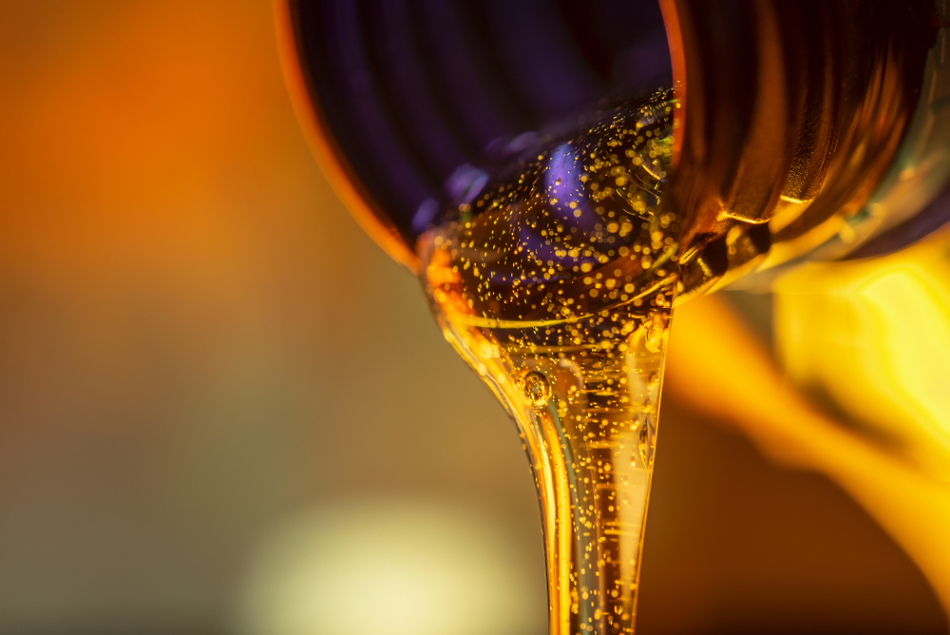
Image Credit: IU Liquid and water photo/Shutterstock.com
The optical properties of lubricating greases such as urea, lithium, extreme pressure lithium, and molybdenum disulfide lithium greases have been studied using terahertz time-domain spectroscopy. Different lubricating oils have revealed unique spectral features in the terahertz range.
When these spectra were compared with the predictions based on Lorentz—Lorenz theory, it was found that refractive indices of each kind of lubricating grease were dependent on its consistency.
Categorizing Oils
Oils can be optically described by two parameters, namely, light absorption coefficient and light refraction coefficient. Absorption coefficient spectra analyze with respect to the color of oil, whereas, refraction coefficient spectrum influences both refractive as well as reflective properties of the interface between oil and surroundings.
Spectra of the absorption coefficient and refraction coefficient possess distinctive slopes in the ultraviolet edge of the spectrum. The values of mentioned coefficients decrease from extremely high in ultraviolet to relatively low in visual range.
Due to storage and operation processes, the quality parameters of petroleum products may
deteriorate, which can be evaluated in terms of the color and transparency. The addition of gasoline, water, coolant and other contaminants into the engine lubricant affects the optical properties of a liquid medium, such as transparency, absorption, and refractive index.
Optical properties may be regarded as simple indicators of specific operational characteristics of the substance. This is especially useful in difficult conditions such as in marine environments where full laboratory test equipment might not be available.
Investigating Fuels
Determination of the spectral radiation properties of fluids was carried out using a double-thickness transmission model, the reliability of which was demonstrated by the conformity between the recorded optical constants and the existing literature.
The spectral radiation properties of diesel, gasoline, and jet fuel, were measured in the wavelength range of 1000–2100 nm across a wide range of temperatures (from room temperature to 423 K). In the case of low carbon fuels, the absorption index was found to be smaller (1100–1450 nm) when compared to high carbon fuels (1700–2000 nm) at room temperature.
The responsiveness of the absorption index to temperature was different for fuels with varying degrees of carbon content. For low carbon fuels, the index increased with temperature at a maximum rate of 50% per degree increment, starting at room temperature. The results showed varying patterns of high carbon fuels. For example, in the case of diesel, the absorption index decreased with the temperature at a peak rate of 40% per degree, while no such pattern was noted for jet fuel. The results provide indirect evidence to support the hypothesis that there is no clear relationship between temperature and refractive index.
Another aspect of modeling of the contrast of oil slick on the sea surface requires running computer simulations whose input is the number of photons tracks in the marine environment. In this modeling approach, many additional factors are studied such as oil thickness (10 Pm), the direction of incidence of sunlight (perpendicular), the state of the surface (no wind), and the optical properties of seawater (typical for the coastal zones).
Due to the study of these variable factors, the establishment of an objective relationship between the visibility of oil slick and the fundamental optical properties of oil have been made possible.
The behavior of the non-linear absorption (NLO) coefficient and the non-linear refractive index (NLRI) in lubricating oil have been widely studied using Z-scan technique and the single-beam technique developed by Sheikh-Bahae et al. (1990).
Nanofluid fuel deals with the addition of nanomaterials (such as metals, oxides, carbides, nitrides, or carbon-based nanostructures) to liquid fuels. These fuels can enhance ignition and combustion. The investigation of the optical properties has revealed that the transmission spectra of the nanofluids are measured in a wide wavelength range from UV (250 nm) to near IR (800 nm).
References and Further Reading
Sebastián-DíazTovar, J., Valbuena-Duarte, S., Racedo-Niebles, F. (2018). Study of non-linear optical properties in automobile lubricating oil via Z-Scan technique. Revista Facultad de Ingeniería, No.86, pp. 27-31.
Merola, S., Tornatore, C., Marchitto, L., Valentino, G. et al., (2014). Optical Properties Investigation of Alternative Fuels Containing Carbon-Based Nanostructures. SAE Technical Paper 2014-01-2765.
Otremba, Z., & Toczek, H. (2011). Optical Properties of Fuels and Lubricants vs. Aquatic Environment Protection Issues. Journal of KONES Powertrain and Transport, 18(4).
Disclaimer: The views expressed here are those of the author expressed in their private capacity and do not necessarily represent the views of AZoM.com Limited T/A AZoNetwork the owner and operator of this website. This disclaimer forms part of the Terms and conditions of use of this website.